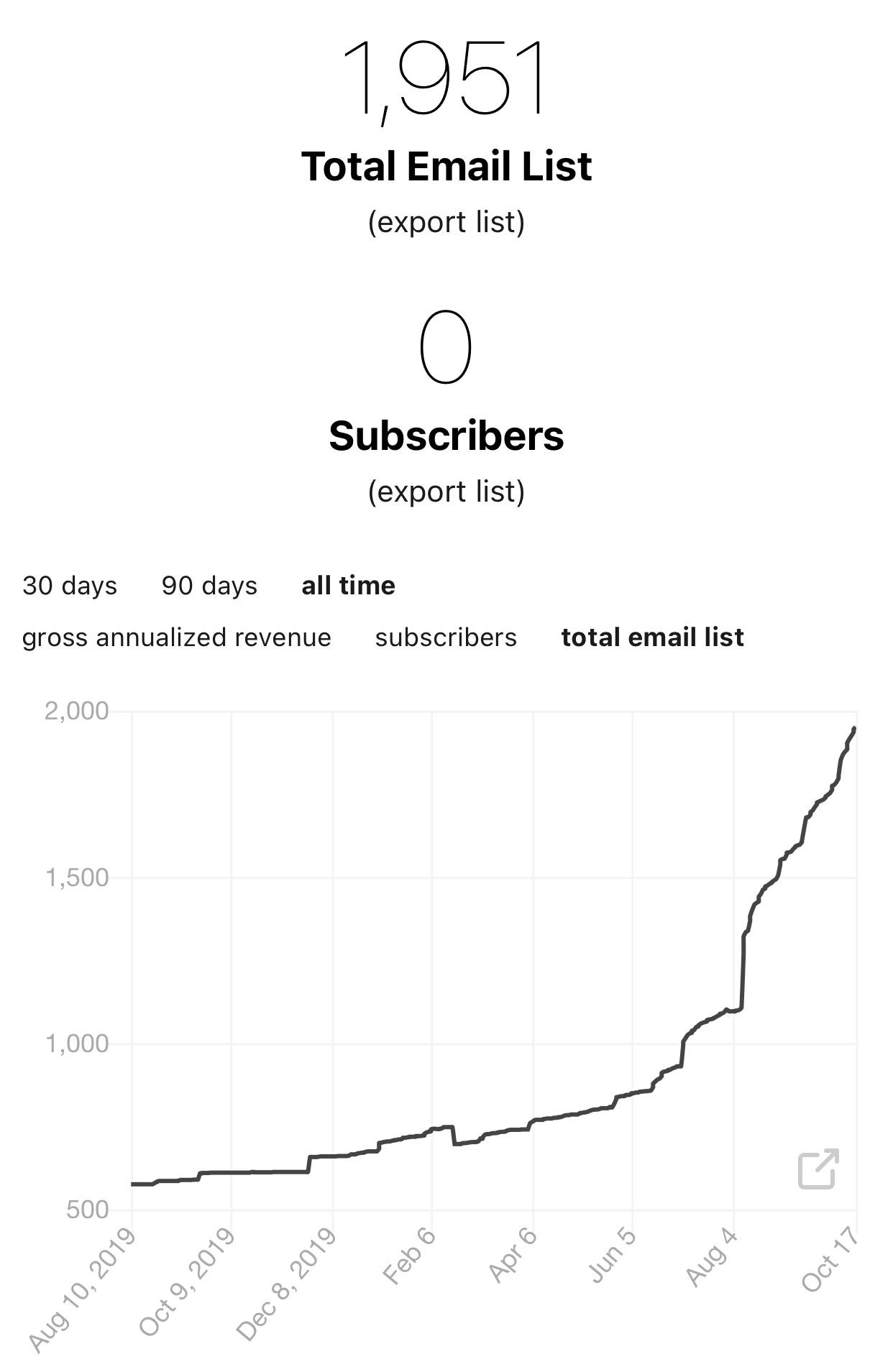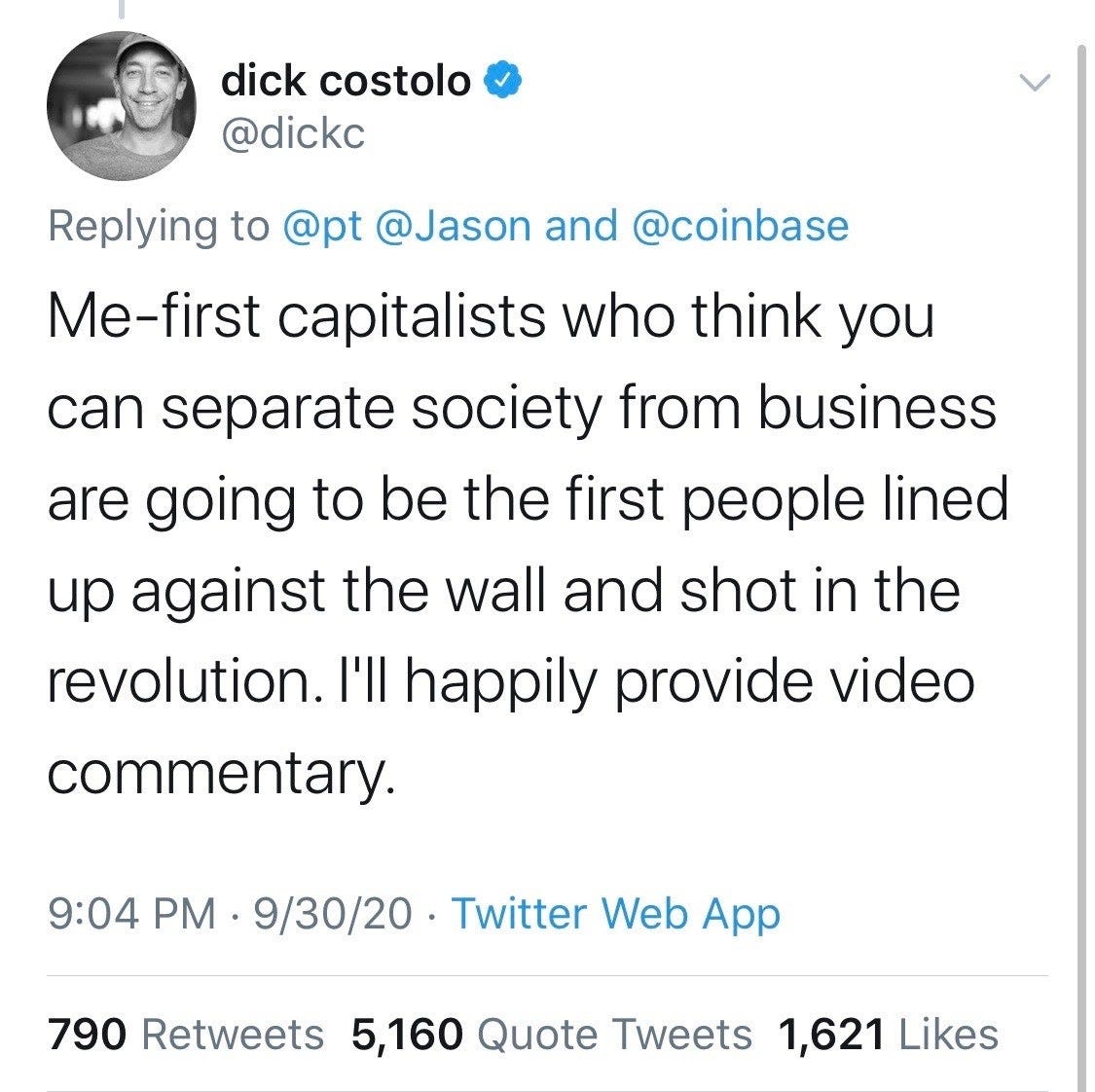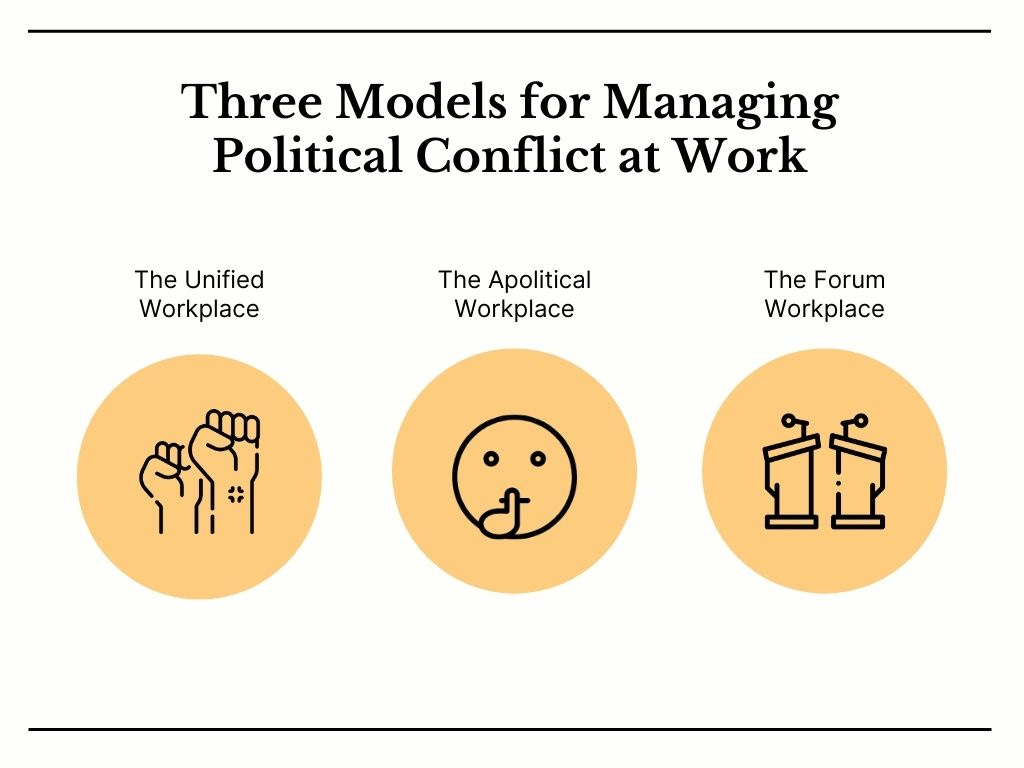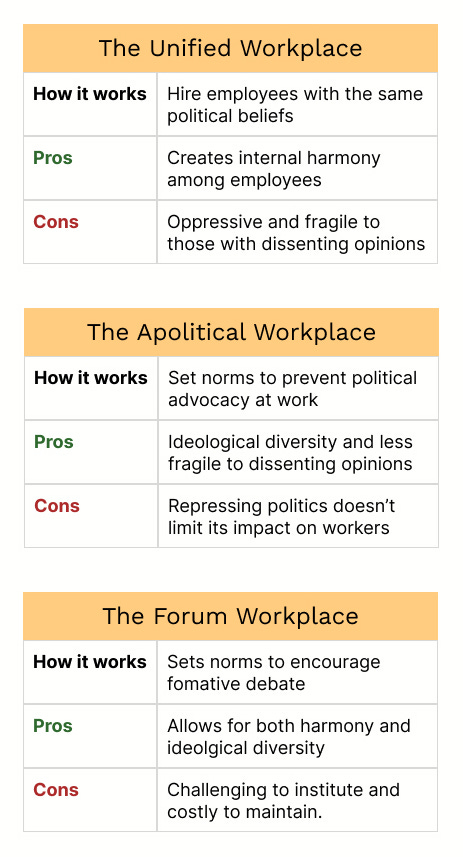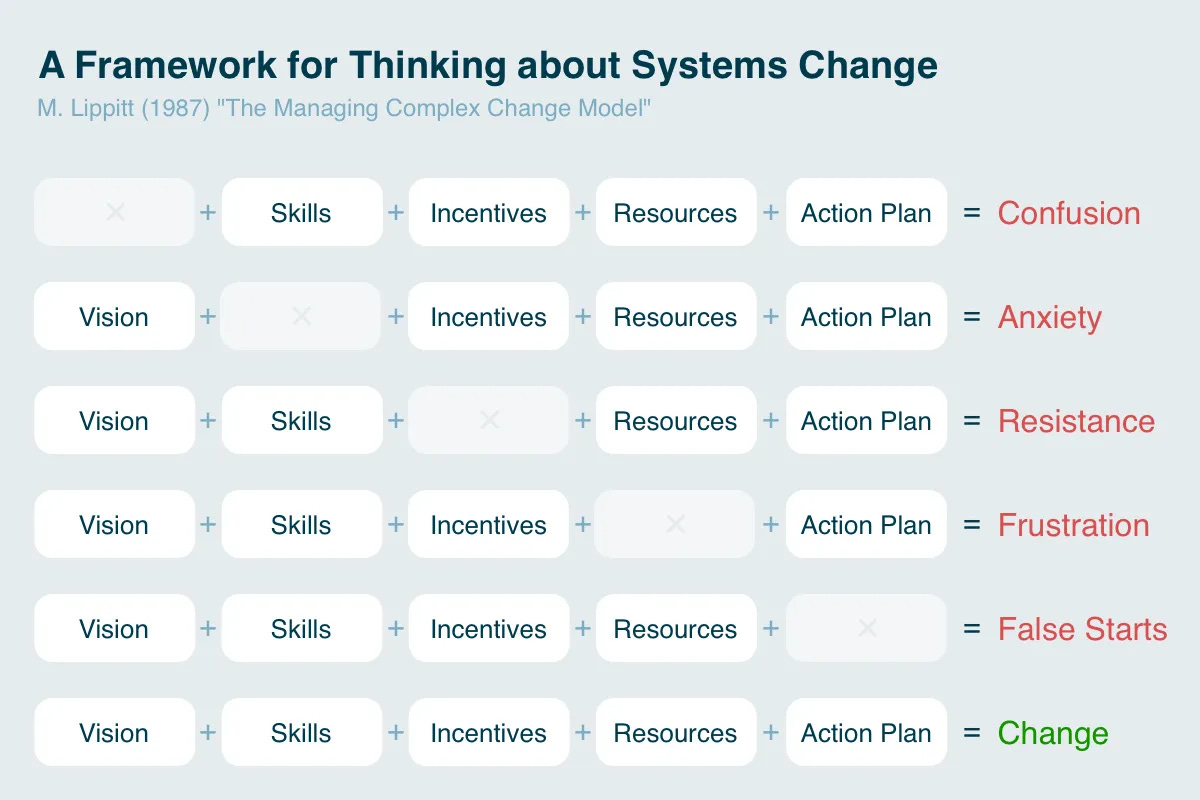Hey there, I’m Nick, and you’re reading The Jungle Gym – a newsletter to help you think clearer and work smarter.
Each month I publish 2 newsletters with different formats. This format is 💌 The Roundup. It features a longer-form essay along with riffs on some good content I’ve been reading lately.
If you're new here, check out this introductory post to learn what The Jungle Gym is all about.
And, if you aren't yet a subscriber and want to sign up for future issues, enter your email here:
The Rundown
Here's a rundown on what this issue of The Jungle Gym will cover:
Featured Essay
🥊 Work and Let Work: Three models for managing political conflict
Is it possible to create a company culture that promotes political advocacy without undermining employee cohesion?
Recommendations & Riffs
⚙️ Barriers preventing change at work
🏆 New models for coaching enabled by remote work
♟ Learning to be strategic
🏃♀️ How action produces information
💼 A sociopath’s guide to getting promoted
🔮 Rules For Predicting The Future
Before we get into it a couple of updates…
Podcast interview – I recently had the pleasure of recording a podcast episode with my friend Rob Stevenson who hosts Talk Talent to Me. It’s a fun conversation. I’d encourage you to listen to on 2X, so we both sound smarter.
Reaching my stretch goal – Back in July, after this newsletter had its first big surge of subscribers, I set a goal myself– 1500 subscribers by the end of 2020.
Thanks to all of you, as well as the almighty distribution algorithm, I exceeded that goal and have set my sights on 2000 subs by the end of the year. Here’s where I am, as of yesterday:
(Dip in February came from purging a bunch of subscribers who never opened my emails)
If you’ve got it in you, I’d appreciate it if you could forward this newsletter to someone who you think might enjoy it.
Okay, let’s get into it.
Work and Let Work: Three models for managing political conflict
If you’ve any spent time on Twitter recently, you likely encountered this manifesto from Coinbase CEO Brian Armstrong discouraging political advocacy at his company.
The resulting debate both strengthened Armstong’s case for the toxicity of politics and managed to embroil him in the type of controversy he hoped to rid from his company.
Whatever your opinion about the memo, it’s hard to deny that we humans aren’t very good at restraining our political polarization. This is particularly true in 2020, when our party affiliations have become so intertwined with our identities.
How can companies prevent political conflict from undermining company cohesion? Here are three models to consider for anyone attempting to build an organizational culture:
Model #1: The Unified Workplace
Companies using this model hire employees who share similar beliefs about most contentious topics. This allows workers to share their views on issues like abortion, gun rights, and immigration without worrying about creating conflict with co-workers.
To build and maintain this model, companies must:
Pick a popular party affiliation
Publicly express values that dissuade employees with incompatible beliefs from applying
Screen out candidates with misaligned views during the hiring process (Note: some states protect job seekers from this type of political discrimination)
This strategy can work for both left and right-leaning companies. It’s safe to say that Patagonia and Ben & Jerry’s don’t spend much energy mediating the opinions of Trump-voting employees. Likewise, Hobby Lobby and Chik-fil-A probably get very few job applications from AOC supporters.
With this type of model, it’s less important whether an employee shares the dominant position on an issue than whether they stand in opposition. For example, in a left-leaning company, an employee who’s ambivalent about abortion doesn’t threaten the peace. Meanwhile, an avid pro-life employee can create a lot of controversy.
When this approach works, it creates harmony on several levels. The company stays compatible with its customers. Managers don’t need to mediate heated political debates. Individual employees can go to work without repressing their views on topics they care about.
The disadvantage of this model is that it’s fragile. Take Google. While the company may not explicitly follow this model, its employee base certainly leans progressive. This made James Damore’s 2017 memo accusing Google of being an ideological echo chamber all the more explosive.
This model can also be oppressive to workers with divergent political views that slip through the hiring filter. It’s hard enough to navigate typical workplace politics without learning and performing your boss’ political beliefs. While workers always have the right to part ways with their employers, this option is significantly riskier for low-wage workers living paycheck to paycheck.
In response to these drawbacks, companies like Coinbase have pushed to remove workplace politics altogether.
Model #2: The Apolitical Workplace
Rather than filtering employees based on their views, the apolitical workplace restricts political advocacy altogether.
To work, this model requires enforcement at the top and bottom of the organization. The CEO must remain neutral and not influence employees toward his or her favorite political party. However, the CEO can’t monitor every Zoom meeting and Slack conversation. Employees must believe enough in neutrality to avoid the temptation of impromptu political conflict.
Apolitical companies have the potential to sustain much more ideological diversity than unified ones. This allows them to craft messages and build products that appeal to a much broader market.
They are also less fragile to flare-ups of political conflict since employees have implicitly agreed to restrain their politics. Returning to the Damore memo, it would have been much easier for an organization like Coinbase to discipline the author since the company would have had norms against that type of expression.
The problem with this model is that it assumes repressing politics can make it go away. This simply isn’t the case. When workers are forced to grapple with America’s health care or criminal justice systems, you can be sure they will bring these experiences into work. If employees feel pressured to withhold these feelings from coworkers, they are depriving their manager and teammates of the type of critical information needed to maintain a functioning team.
So is there some kind of happy medium?
Model #3: The Forum Workplace
The Forum Workplace attempts to foster both ideological diversity and political engagement, without unleashing conflict. To pull this off, companies need to distinguish between two types of debate:
Formative debate – where the purpose is to express ideas that change minds
Performative debate – where the goal is tribal signaling and public shaming
To create a culture that fosters formative debate requires enforcing norms that sit above the political beliefs or emotional state of any single employee. Some examples of useful norms include:
Handling political disagreements through direct exchanges vs. public forums, like Slack
Avoiding divisive labels or impugning others’ motives
Attempting to steelman arguments before attacking them
Creating a culture that celebrates “belief updating”
When executed thoughtfully, this model should offer the advantages of political diversity and free expression without the drawbacks of the unified or apolitical workplaces.
So why don’t all companies use this model? Because it’s not a competency most businesses are willing to prioritize. Companies only have so many resources to invest in creating culture. Is promoting formative debate more valuable than creating a culture of customer obsession or product excellence? Probably not.
There’s also no guarantee investments here will produce a return. Even institutions like universities, that are designed to foster open inquiry, have trouble building fostering formative debate.
Work and Let Work
Each of these models has its benefits and drawbacks:
Each of them should be tried, along with plenty of other experiments.
As someone who enjoys formative political debate and having his mind changed, I can’t imagine enjoying working at Coinbase. But I also don’t think I’d like working at a company that encourages unfiltered political discourse either. Luckily, there are lots of companies to choose from, and they aren’t all trying the same thing.
Before the rise of social media, one thing that limited political conflict in our country was the ability of groups to start experimental communities. This allowed cities ranging from Berkeley, California (one of the most progressive cities in America) to Mesa, Arizona (one of the most conservative) to try building their own utopias. If these people had to share the same city, they would all be miserable.
The same holds when it comes to companies. If Patagonia or Chik-Fil-A employees had to work together, they would all be worse off.
As long as companies follow the laws, don’t discriminate, are inclusive of those who share their values, and allow people to exit if they aren’t happy, we should let these experiments run.
What’s important is that leaders are intentional about the cultures they are building and proactively communicate their values to potential hires.
Coinbase’s experiment is as useful as any other. If it turns out no one wants to work there, we will all have learned a valuable lesson. If it becomes a hotbed for productive innovation, we can figure out how to replicate and improve on its model.
Work and let work.
Recommendations & Riffs
⚙️ A Framework for Thinking About Systems Change
(2-minute read by Erin 'Folletto' Casali)
At a small company, it’s relatively easy to change things. Often, the limiting factor is money.
As a company grows, change becomes harder to initiate. But that’s no longer because the company lacks money. The limiting factor is likely to be the consent of co-workers.
This framework offers a great model for change-management and diagnosing what’s wrong when any system seems reluctant to change.
🏆 Personal Best
(35-minute read by Atul Gawande)
With so many of our work interactions happening in Zoom and Slack, coaching for knowledge workers has the potential to get a lot better.
The big change with remote work is that you and your coach have a lot more “game-tape” to review and dissect. This will inevitably lead to better insights and improve the value of coaching.
As coaching gets better, adoption will follow. At some point, I wouldn’t be surprised if it’s as rare to find an uncoached elite knowledge worker as it is to find an uncoached world-class athlete.
♟ Learning and Doing Strategy
(5-minute read by Andrew Bartholomew)
It seems like everyone I talk to wants to learn to become “more strategic.” While good books exist on strategy, its hard to master without a forum for practice.
One of the best ways to get practice cycles is by joining a company that has a thoughtful process for strategic decision-making. This requires setting top-down priorities that allow people to make hard choices and gathering feedback about how those choices shape the output of the organization.
🏃♀️ Action Produces Information
(14-minute read by Cedric Chin)
While it’s valuable to study decision-making frameworks, getting too caught up in decision analysis has several limitations:
You may not be aware of all the options you should be considering.
An option’s utility can diminish if you spend too long deciding.
Action creates new information that can help you make better choices.
The key to being a good practical decision-maker is to know when action is required to generate more options or better information. Particularly when a decision is reversible, it’s worth taking action sooner as “the information that comes from action is often more valuable than the insight that comes from analysis.”
💼 How to get promoted
(10-minute read by Slava Akhmechet)
Lately, I’ve been wondering what prevents managers from hiring more freelancers. From what I’ve witnessed, freelancers, with their subject matter expertise and hourly billing, often generate a considerably higher return than their salaried counterparts.
I suspect that a big reason has to do with the link between headcount and promotions. This post directed at ladder-climbing opportunists sums it up nicely:
Your primary objective is simple— headcount growth. Figure out the baseline headcount growth rate for the company, and grow your team at least as much. Any less, and you'll be left in the dust. More is better— superstars always grow their headcount considerably faster than baseline.
Don't worry about what all these people will work on. The devil will conveniently find work for idle hands. Expanding companies never have a shortage of business opportunities, projects, and tasks. The work will invent itself. Your job isn't the work— it's to grow headcount and make it appear well-managed.
🔮 A Few Rules For Predicting The Future
(8-minute read from Octavia E. Butler)
I’ve always viewed the purpose of science fiction as a tool to steer humanity toward or away from possible futures. But first, you need to get good at prediction. Octavia E. Butler was a science fiction writer who had a great perspective on what it takes to see into the future:
Learn from the Past
The past is filled with repeating cycles of strength and weakness, wisdom and stupidity, empire and ashes. To study history is to study humanity. And to try to foretell the future without studying history is like trying to learn to read without bothering to learn the alphabet.
Respect the Law of Consequences
I don’t believe we can do anything at all without side effects–also known as unintended consequences. Those consequences may be beneficial or harmful. They may be too slight to matter or they may be worth the risk because the potential benefits are great, but the consequences are always there.
Be Aware of Your Perspective
Some of the most mistaken predictions I’ve seen are of the straight-line variety–that’s the kind that ignores the inevitability of unintended consequences, ignores our often less-than-logical reactions to them, and says simply, “In the future, we will have more and more of whatever’s holding our attention right now.” If we’re in a period of prosperity, then in the future, prosperity it will be. If we’re in a period of recession, we’re doomed to even greater distress.
Count on Surprises
So why try to predict the future at all if it’s so difficult, so nearly impossible? Because making predictions is one way to give warning when we see ourselves drifting in dangerous directions. Because prediction is a useful way of pointing out safer, wiser courses. Because, most of all, our tomorrow is the child of our today. Through thought and deed, we exert a great deal of influence over this child, even though we can’t control it absolutely. Best to think about it, though. Best to try to shape it into something good.
Community
I use the Jungle Gym Community Hub to recommend some of the great publications from readers and give shoutouts to those of you who accomplished impressive things this month.
If I missed something cool that you did or are writing, please drop me a note so I can add it!
If you found this issue of the newsletter valuable, I'd really appreciate it if you could forward it to a friend, family member, or colleague who you think might enjoy it.
Or, if you'd like to share it on one of your social networks, that would be great as well.
Until next time,
Thanks to: Ashley, Justin, Kevin, Kushaan, Lea, Louis, Lyle, Nate, Nick, Padmini, Parthi, Sachin for sharing thoughts on early drafts.




